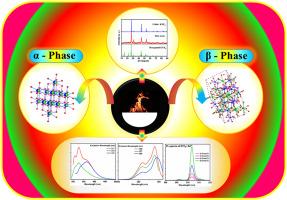Synthesis and spectroscopic analysis in KYF4: Ce3+/Gd3+: A UV emitting phosphor synthesized by solid state metathesis
IF 5.6
2区 材料科学
Q1 MATERIALS SCIENCE, CERAMICS
引用次数: 0
Abstract
Synthesis of KYF4 by solid state metathesis is reported. XRD results indicated almost pure cubic phase with some weak lines of hexagonal phases. Luminescence of Ce3+, on the other hand, showed presence of Ce3+ centres in both cubic and hexagonal phases. Luminescence spectra in two phases differ. Emission in the cubic phase lies at longer wavelengths as compared to that in the hexagonal phase. The difference is attributed to the weaker crystal field in the hexagonal phase. Two phase structure was not reflected in the luminescence of Gd3+. Gd3+ luminescence originates in f-f transitions which are less sensitive to the structural changes as compared to the f-d transitions of Ce3+. These results can explain the inconsistencies in the literature reports on Ce3+ luminescence in KYF4. These investigations also furnish a fast method for preparing KYF4 based phosphors.

KYF4: Ce3+/Gd3+:固态合成紫外发光荧光粉的合成及光谱分析
报道了固态复分解法制备KYF4。XRD结果表明,六方相中有微弱的六方相线,几乎为纯立方相。另一方面,Ce3+的发光表明在立方相和六方相中都存在Ce3+中心。两相的发光光谱不同。与六方相相比,立方相的发射波长更长。这种差异是由于六方相的晶体场较弱。两相结构不反映在Gd3+的发光中。Gd3+的发光源于f-f跃迁,与Ce3+的f-d跃迁相比,f-f跃迁对结构变化的敏感性较低。这些结果可以解释文献报道中Ce3+在KYF4中发光的不一致性。这些研究也提供了一种快速制备KYF4基荧光粉的方法。
本文章由计算机程序翻译,如有差异,请以英文原文为准。
求助全文
约1分钟内获得全文
求助全文
来源期刊

Ceramics International
工程技术-材料科学:硅酸盐
CiteScore
9.40
自引率
15.40%
发文量
4558
审稿时长
25 days
期刊介绍:
Ceramics International covers the science of advanced ceramic materials. The journal encourages contributions that demonstrate how an understanding of the basic chemical and physical phenomena may direct materials design and stimulate ideas for new or improved processing techniques, in order to obtain materials with desired structural features and properties.
Ceramics International covers oxide and non-oxide ceramics, functional glasses, glass ceramics, amorphous inorganic non-metallic materials (and their combinations with metal and organic materials), in the form of particulates, dense or porous bodies, thin/thick films and laminated, graded and composite structures. Process related topics such as ceramic-ceramic joints or joining ceramics with dissimilar materials, as well as surface finishing and conditioning are also covered. Besides traditional processing techniques, manufacturing routes of interest include innovative procedures benefiting from externally applied stresses, electromagnetic fields and energetic beams, as well as top-down and self-assembly nanotechnology approaches. In addition, the journal welcomes submissions on bio-inspired and bio-enabled materials designs, experimentally validated multi scale modelling and simulation for materials design, and the use of the most advanced chemical and physical characterization techniques of structure, properties and behaviour.
Technologically relevant low-dimensional systems are a particular focus of Ceramics International. These include 0, 1 and 2-D nanomaterials (also covering CNTs, graphene and related materials, and diamond-like carbons), their nanocomposites, as well as nano-hybrids and hierarchical multifunctional nanostructures that might integrate molecular, biological and electronic components.
 求助内容:
求助内容: 应助结果提醒方式:
应助结果提醒方式:


